هون الخان
Alchon Huns | |||||||||||||||||||
|---|---|---|---|---|---|---|---|---|---|---|---|---|---|---|---|---|---|---|---|
| 380–560 | |||||||||||||||||||
 Tamga of the Alchon Huns | |||||||||||||||||||
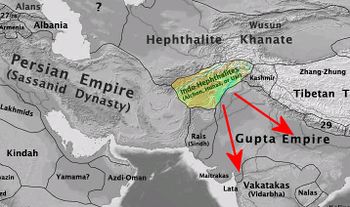 Alchon territories and campaigns into Gujarat and Madhya Pradesh, circa 500 CE. | |||||||||||||||||||
| العاصمة | كابيسا | ||||||||||||||||||
| اللغات الشائعة | براهمي و Bactrian (written) | ||||||||||||||||||
| الدين | البوذية والهندوسية | ||||||||||||||||||
| الحكومة | امبراطورية رحالة | ||||||||||||||||||
| Tegin | |||||||||||||||||||
• 430 – 461 م | Khingila | ||||||||||||||||||
• 461 – 493 م | مهاما | ||||||||||||||||||
• 493 – 515 | تورامانا | ||||||||||||||||||
• 515 – 540 م | ميهيراكولا | ||||||||||||||||||
• 540 – 570 CE | Toramana II | ||||||||||||||||||
| الحقبة التاريخية | القدم المتأخر | ||||||||||||||||||
• تأسست | 380 | ||||||||||||||||||
• انحلت | 560 | ||||||||||||||||||
| Currency | درخم هوني | ||||||||||||||||||
| |||||||||||||||||||
| Today part of | |||||||||||||||||||
هون الخان (Alchon Huns ؛ Sanskrit: Hūṇas)، أيضاً Alkhan Huns,[1] were a group of nomads who established states in central and southern Asia. They were part of the four major "Hunic" states known collectively as Xionites or "Hunas", being preceded in southern Asia by the Kidarites and the Hephthalites, and succeeded by the Nezak Huns.
The Alchons appeared in the Paropamisadae and later expanded into the Punjab and central India as far as Eran and Kausambi. Their invasion of Indian territory follows that of the Kidarites about half a century earlier.[2][3] It greatly weakened, and contributed to the fall of, the Gupta Empire. Their invasion of India follows numerous other invasions in the preceding centuries, such as those of the Indo-Greeks, the Indo-Scythians or the Kushans.[4]
We know of the names of the Alchon kings from their extensive coinage and from inscriptions in Buddhist stupas.
التاريخ
The Alchon Huns emerged in Kapisa around 380, taking over Kabulistan from the Sassanian Persians, at the same time the Kidarites (Red Huns) ruled in Bactria and Ghandara. They are said to have taken control of Kabul in 388.[1]
Gandhara
Around 430 king Khingila, the most notable Alchon ruler, emerges and takes control of the routes accross the Hindu Kush from the Kidarites.[1] As the Alchons Huns took control, diplomatic missions were established in 457 with China.[5] In 460, the Alchons conquered Taxila. Between 460-470 CE, as they took over Gandhara and Punjab, the Huns apparently undertook the mass destruction of Buddhist monasteries and stupas at Taxila, a high center of learning, which never recovered again from these destructions. The rest of the 5th century marks a period of territorial expansion and eponymous kings (Tegins), several of which appear to have overlapped and ruled jointly.
الحرب الهونية الأولى: وسط الهند
معركة إران الأولى (510 م)
A particularly decisive encounter occurred in Malwa, where a local Gupta ruler, probably a Governor, named Bhanugupta was ruling. In the Bhanugupta Eran inscription, this local ruler reports that he participated in a great battle in 510 CE at Eran, where he suffered severe casualties.[6] According to a 6th century CE Buddhist work, the Manjusri-mula-kalpa, Bhanu Gupta lost Malwa to the Sudra Toramana, who continued his conquest to Magadha, forcing Narasimhagupta Baladitya to make a retreat to Bengal. Toramana is said to have crowned a new king in Benares, named Prakataditya, who is also presented as a son of Narasimha Gupta.[7][6]
التقهقر إلى كابولستان
الدين والأخلاق

اضطهاد البوذية

The 12th century Kashmiri historian Kalhana too painted a dreary picture of Mihirakula's cruelty, as well as his persecution of the Buddhist faith:
"In him, the northern region brought forth, as it were, another god of death, bent in rivalry to surpass... Yama (the god of death residing in the southern regions). People knew of his approach by noticing the vultures, crows and other birds flying ahead eager to feed on those who were being slain within his army's reach. The royal Vetala (demon) was day and night surrounded by thousands of murdered human beings, even in his pleasure houses. This terrible enemy of mankind had no pity for children, no compassion for women, no respect for the aged"
العواقب على الهند
تلك الغزوات، بالرغم من أنها لم تستمر إلا لبضع عقود، كان لها أثراً بعيداً على الهند، وبشكلٍ ما أنهت الحضارة الهندية الكلاسيكية.[12]
المصادر
العملات
Silver drachm of مهاما
Silver drachm of Mihirakula
Coin of Toramana II, circa 540-570 CE.
Javukha of the Alchon Huns Mid-late 5th century.jpg
لاخانا من هون الخان، من آخر القرن الخامس أو أول القرن السادس.
Adomano of the Alchon Huns, mid-late 5th century.
Narana-Narenda of the Alchon Huns, late 4th-early 5th century CE.
Khingila as a young king, without headdress. Artificial cranial deformation clearly visible.[16]
ختم Sardonyx يمثل ڤشنو مع متعبد (لعله ميهيراكولا)، القرن 4-6 الميلادي. النقش بالباكترية الرِقعة يقول: "ميهيرا وڤشنو و شيڤا". المتحف البريطاني.
See also
References
- ^ أ ب ت The Cambridge Companion to the Age of Attila, Michael Maas p.286
- ^ History of Civilizations of Central Asia, Ahmad Hasan Dani, B. A. Litvinsky, Unesco p.119 sq
- ^ The Huns, Hyun Jin Kim, Routledge, 2015 p.50 sq
- ^ Concise Encyclopeida Of World History by Carlos Ramirez-Faria [1]
- ^ Early Buddhist Transmission and Trade Networks by Jason Neelis [2]
- ^ أ ب The Gupta Empire, Radhakumud Mookerji, Motilal Banarsidass Publ., 1959 p.120
- ^ Early history of Jammu region, Raj Kumar, Gyan Publishing House, 2010 p.538
- ^ Coin Cabinet of the Kunsthistorisches Museum Vienna [3]
- ^ CNG Coins [4]
- ^ The Identity of Prakasaditya by Pankaj Tandon, Boston University [5]
- ^ CNG Coins [6]
- ^ أ ب خطأ استشهاد: وسم
<ref>غير صحيح؛ لا نص تم توفيره للمراجع المسماةEraly - ^ Hans Bakker 24th Gonda lecture
- ^ For reference CNG Coins [7]
- ^ CNG coins [8]
- ^ CNG Coins [9]
وصلات خارجية
- http://pro.geo.univie.ac.at/projects/khm/showcases/showcase11?language=en
- http://grifterrec.rasmir.com/huns/huns.html
- Pages using infobox country with unknown parameters
- Pages using infobox country or infobox former country with the symbol caption or type parameters
- Pages using multiple image with auto scaled images
- Articles with hatnote templates targeting a nonexistent page
- الأسر الحاكمة في أفغانستان
- History of Ghazni Province
- جماعات بدوية في أوراسيا
- Huns
- Ancient history of Afghanistan
- Ancient history of Pakistan
- بلدان سابقة في آسيا
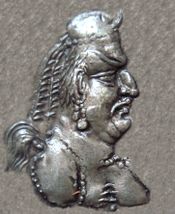
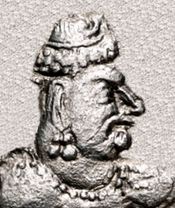


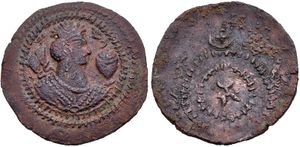
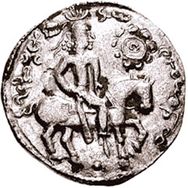
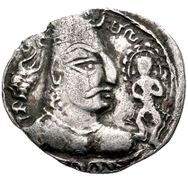

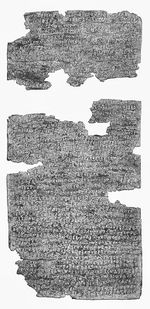
![Silver drachm of Khingila, legend: "Khiggilo Alchono".[14]](/w/images/thumb/2/2b/HunCoinDerivedFromSassanianDesign5thCE.JPG/120px-HunCoinDerivedFromSassanianDesign5thCE.JPG)
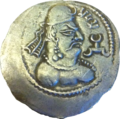

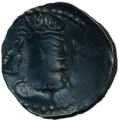

![Khingila of the Alchon Huns Circa 440-490 CE.[15]](/w/images/thumb/6/6d/Khingila_of_the_Alchon_Huns_Circa_440-490_CE.jpg/120px-Khingila_of_the_Alchon_Huns_Circa_440-490_CE.jpg)




![Khingila as a young king, without headdress. Artificial cranial deformation clearly visible.[16]](/w/images/thumb/b/b9/Khingila_of_the_Alchon_Huns_young_circa_AD_440-490.jpg/107px-Khingila_of_the_Alchon_Huns_young_circa_AD_440-490.jpg)
